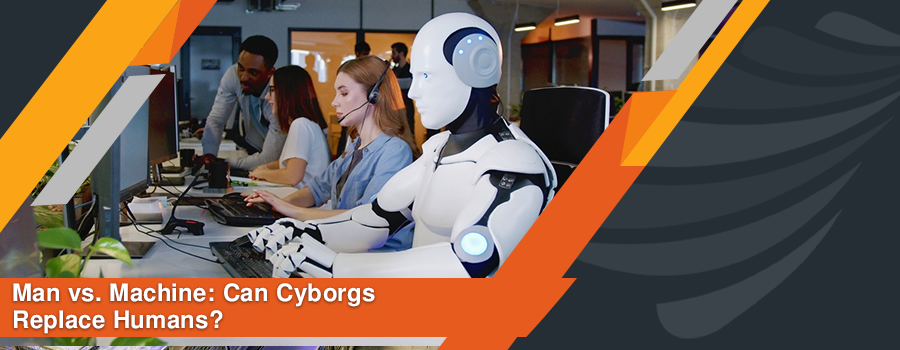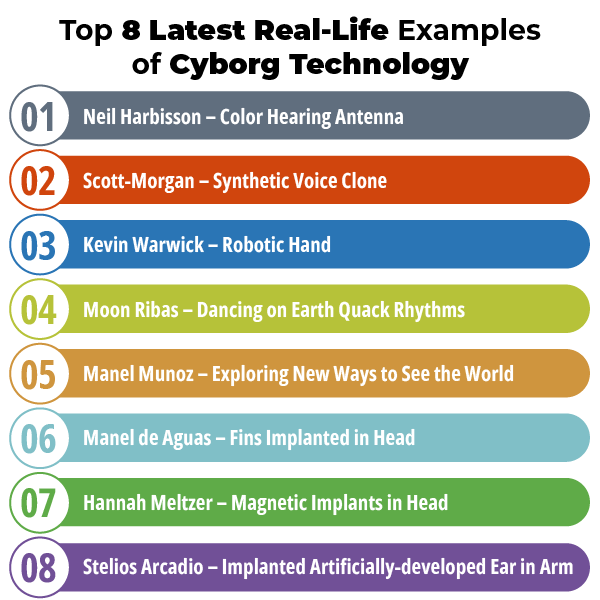We, as humans, are true survivors because of our intelligence, strength, and survival instincts. Our present generation now relies more on machines, implants, and robotics, meaning we need fewer humans to depend on. Can it result in decreasing population of Homo sapiens from Earth to complete extinction?
The future world reflects a life where the thin line between humans and machines may blur. Imagine when humans merge with machinery to gain super-powerful capabilities and intelligence.
The emergence of cyborg technology has made this science fiction a reality. From bionic limbs to neural implants, cyborgs revolutionize human living.
In this blog, we will navigate a new concept known as ‘cyborg’ to understand whether it crosses the human-machine boundary or improves human lives.
What is Cyborg Technology?
A cyborg or cybernetic organism refers to a being that reflects fusions between biological and artificial components.
You can take it as someone who restored his functions or enhanced his abilities by relying on machines or implants. You can call a human a cyborg if he has implants like insulin pumps or heart valves.
The Cyborg’s Dilemma: Fusion of Biological and Artificial Components
Cyborg’s dilemma is a modern paradox that allows us to question whether we can exchange nature or humanity with technological advancements.
Imagine you have a microchip implant to enhance memory and a cybernetic arm to possess more strength. After this, you may always be considered better than a normal human and get better opportunities for living.
But you can not ignore that it takes you away from nature. You won’t be acknowledged for your achievements but for your gadgets and implants.
The question here is whether it is the right path. By possessing more strength or memory, you may lose the real essence of the human version. You can store more data but not knowledge and learning. Relying more on machines can make you forget how naturally you can boost your skills, intelligence, and power.
Before deciding it as a negative concept, we must consider that every advancement has benefits, challenges, and ethical dilemmas. Therefore, we must understand these perspectives to understand whether cyborg technology brings a positive or negative phase of human evolution.
Top 8 Latest Real-Life Examples of Cyborg Technology
1. Neil Harbisson – Color Hearing Antenna
Neil Harbisson was born in a black-and-white world. In 2004, his colorless experience changed into a vibrant tapestry of hues.
An electronic antenna was implanted into the lower back of his skull that mounted on his forehead. It turns light frequencies into vibrations in his brain, allowing him to hear colors. Not only this, he was also able to hear invisible frequencies like ultraviolet and infrared.
2. Scott-Morgan – Synthetic Voice Clone
Scott-Morgan is a robotic expert known as the most advanced human cyborg. After his diagnosis of motor neuron disease in 2017, he improvised his life with the help of advanced technologies, groundbreaking surgeries, and implants.
One of the greatest human-machine integrations was removing his voice box and designing a lifelike avatar and synthetic voice clone.
The power of AI-based software and an advanced robotic wheelchair allowed him to communicate with facial expressions. He interacted with people via a screen on his chest and survived longer than expected.
Finally, in 2019, he was officially started to call ‘Peter 2.0.’
3. Kevin Warwick – Robotic Hand
Kevin Warwick’s work is known for linking the nervous system with robotics. Through different surgical procedures, he was the first to successfully implant a device in his left arm. His robotic hand got signals from his nervous system, allowing him to control his hand from anywhere in the world.
4. Moon Ribas – Dancing on Earth Quack Rhythms
Moon Ribas, a contemporary dancer, implanted sensors in her feet, allowing her to respond to seismic activities worldwide. She used these sensations to create unique dance performances. Later, she became a cyborg activist and also worked to spread environmental awareness.
5. Manel Munoz – Exploring New Ways to See the World
Manel Munoz is a Spanish biohacker. He is known for implanting devices and spreading awareness of cyborg technology to improve human capabilities.
One of his most noteworthy works is implanting a Near Field Communication (NFC) chip in his hand, allowing him to enhance his capabilities in different ways, such as sharing information with others, unlocking doors, and paying after buying. Also, he implanted RFID chips that helped him to track movement and location.
Other chips he implanted include a temperature sensor in his chest and a magnetic implant in his finger. These implants help him to explore new ways to interact with the world and improve his quality of life.
6. Manel de Aguas – Fins Implanted in Head
Manel de Aguas is known as a Spanish cyborg artist. He implanted weather sensory fins in his head, allowing him to sense humidity, temperature, and atmospheric pressure changes. He can also predict the changes in the environment with his unique fins.
7. Hannah Meltzer – Magnetic Implants in Head
Hannah Meltzer is a renowned visual performance artist. She implanted magnets in her ears and fingers to detect and feel magnetic fields. She used these powers to add versatility to her artwork. Her most fascinating artworks include sculptures activated by magnetic fields, soundscapes, and music created with magnetic fields.
8. Stelios Arcadio – Implanted Artificially-developed Ear in Arm
Stelios Arcadio, a performance artist, believes that human beings will transform into cyborgs. He implants an artificially developed ear in his left arm through surgery to give new perspectives of cyborgs and attract viewers to the human-machine interface.
In one of his shows, he hooked up electrodes to his body to allow the audience to control his muscles via the web. His amazing human-machine interactions are always the center of attention in the cyborg art field.
Will Humans Eventually Become Cyborgs?
The complete evolution of humans towards cyborgs seems to be a speculative concept. To think about the future evolutionary patterns of humans, we must consider the factors that can hinder this evolutionary change. These factors are safety and regulatory concerns, ethical and social principles, individual decisions, medical applications, cost, technological limitations, and threats to humanity.
On one side, a cyborg is beneficial to aid people with disabilities, disease, or any suffering. On the other hand, people use it to enhance their abilities to become a better and smarter version of themselves. Because of people’s increasing interest in top positions, there is a high probability that we will see remarkable cyborg-human versions in the future.
We cannot ignore that rich people can transform themselves into superheroes, leading to high inequality, conflicts, and racism. People will rely on machines and implants instead of improving their skills and learning to gain success and power.
The trajectory of human-machine evolution relies on future developments, trends, and people’s interests. Ultimately, it will be a mutual decision of a whole society to completely evolve into cyborgs or not. Before making any decision, We must examine potential benefits and threats and work to spread awareness accordingly.
Advantages of Cyborg Technology
The potential advantages cyborg technology provides us are:
1. Rehabilitation
The main purpose for which cyborg technology is greatly appreciated is its role for disabled individuals. With advanced features, it helps to restore lost functions such as limb movement, hearing, seeing, and other sensations.
Examples through which it helps disabled people are cochlear implants, pacemakers, prosthetics, and artificial joints.
2. Open New Opportunities
Cyborg is also used to enhance existing capabilities, such as better vision or movement. Also, you can use it to adopt any unique feature or ability, like superpowers such as sensing infrared rays, temperature changes, or enhanced cognitive abilities.
3. Societal Benefits
With cyborgs, we can develop a society where no more people suffer from disability or health issues and can live better, healthier, and longer lives. But we must implement ethical guidelines so no one can use them negatively.
4. Medical Benefits
Cyborg helps to enhance medical procedures. Doctors have become more competent to deal with any severe injury, disease, or disability. To elaborate, doctors can improvise neurological conditions like Parkinson’s disease with deep brain simulations.
Disadvantages of Cyborg
The disadvantages that we must consider before adopting a cyborg are:
1. Unintended Consequences
The Cyborg concept is almost new; therefore, we don’t know to what extent it may cause damage. The increasing dependence on cyborgs may open doors to create social unrest or environmental damage—even such consequences that may become uncontrollable.
2. Cost and Safety
Cyborg is very expensive; therefore, it may encourage inequality in society. Other than this, due to its presence in the early stage of development, several risks are associated with our safety, like implants malfunctioning or being infected.
3. Societal Inequality
Instead of using it to restore functions, people use it to enhance existing capabilities. Also, they use it to become exceptional characters with unique powers – altering nature. Rich people who have easy access become more dominant in the society. They can even gain more opportunities in business, jobs, and careers than human beings – creating inequality.
4. Ethical Concerns
The human-machine integration raises several concerns about autonomy, privacy, beneficence, and non-maleficence. There are still no ethical guidelines available for it. Therefore, we cannot be sure that it won’t be misused.
Cyborg – A Threat or Opportunity?
The motive of every technological update is to assist human beings and to improve the quality of life. Similarly, cyborg has the same aim – to improve or enhance the capabilities of human beings. Cyborg can enhance our quality of life in many ways, but social and ethical concerns exist. Deciding whether it is a threat or opportunity depends on how it is developed and its purpose.
Using a cyborg to assist the patient is a best practice, but enhancing existing capabilities or altering nature is questionable. Extensive research and ethical considerations must be considered to decide our future as human beings or cyborgs.
To Sum Up
The human-machine dynamics are transforming from interaction to genuine partnership. The close interaction between humans and machines is advancing at an unprecedented pace. Cyborg technology is developing; therefore, we must consider several factors, such as social and ethical, to avoid risks and serious damage to human nature. Cyborgs cannot replace humans, but if we rely completely on machines and alter nature to gain power and superiority, we can anticipate an evolution of humans into cyborgs.






